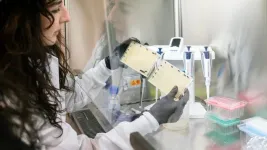(Press-News.org)
Over-the-counter blood pressure measuring devices offer a simple, affordable way for people to track hypertension at home, but the standard arm-size ranges for these devices won’t appropriately fit millions of U.S. consumers, according to a new study from researchers at the Johns Hopkins Bloomberg School of Public Health.
The researchers compared standard arm cuff size ranges for popular retail automatic blood pressure measuring devices to arm circumference data from U.S. government-sponsored national health surveys.
Their analysis revealed that about 6.7 percent of U.S. adults—roughly 17.3 million individuals—have arms that wouldn’t fit standard cuff sizes. For the majority—6.4 percent, an estimated 16.5 million U.S. adults—the cuffs would be too small. They also found that this problem disproportionately affects Black adults, nearly 12 percent of whom have arm circumferences outside the standard available cuff-size range.
Improper cuff fits can result in substantial errors in blood pressure readouts, and may simply prevent people from accurately monitoring their blood pressure at all.
The findings were published September 5 in the journal Hypertension, and will be presented September 6 at the American Heart Association’s annual Hypertension meeting in Chicago.
“The fact that millions of Americans are affected shows that this is not a small problem; and probably the easiest solution is for retailers just to offer a wider range of cuff sizes for no extra cost,” says study senior author Kunihiro Matsushita, MD, PhD, professor in the Bloomberg School’s Department of Epidemiology.
The study’s first author is Eileen Kaur, who was a high school intern in the Matsushita Laboratory at the time the research was conducted.
The authors also recommend that health care providers instruct patients about the importance of selecting proper cuff sizes when buying home blood pressure measuring devices.
Hypertension—typically defined as blood pressure consistently greater than 130/80—is a driver of heart disease, stroke, kidney disease, vision problems, and dementia, and is considered a major cause of premature death worldwide. Treating hypertension properly requires accurate blood pressure measurement. Prior studies have shown poor fitting blood pressure device cuffs reduces measurement accuracy.
For their study, the research team identified 16 popular automatic blood pressure devices sold on Amazon.com in early January 2024, based on reviews and sales in the past month. The team purchased 10 devices. (Several were not available; others were not arm cuffs.) The research team then compared device cuff sizes to a sample of arm circumference measurements among 13,826 American adults included in U.S. National Health and Nutrition Examination Surveys (NHANES) conducted from 2015 to 2020.
Nine devices included cuffs that covered a range of arm circumferences from 22 to 42 centimeters—8.6 to 16.5 inches. One device cuff measured from 22 to 40 centimeters/8.6 to 15.7 inches. The NHANES data indicated that 6.7 percent of U.S. adults, corresponding to 17.3 million individuals based on 2023 U.S. Census numbers, have arm circumferences outside that range—0.3 percent with arm circumferences below 22 centimeters/8.6 inches and 6.4 percent with arm circumferences above 42 centimeters/16.5 inches. The latter translates to an estimated 16.5 million U.S. adults.
The NHANES data, when broken out by race/ethnicity, suggested that 11.8 percent of Black adults, nearly double the national average, have arm sizes outside the standard range. This disparity is particularly concerning, Matsushita says, because Black adults have a significantly higher prevalence of hypertension than other major racial/ethnic groups: 57.1 percent versus 43.6 percent for white adults and 43.7 percent for Hispanic adults.
Some of the devices evaluated in the study did offer cuff sizes outside the standard range, but only as separate items that could be purchased at extra cost after buying the standard package. The researchers recommend that manufacturers of automatic blood pressure devices instead offer a selection of cuff sizes covering a wider range of arm circumferences.
“Consumers should be able to buy the blood pressure cuff sizes they need just as they can buy clothing sizes they need,” Matsushita says.
Even an upward shift of the existing 20 centimeter/8.6 inches range of cuff sizes, to 25 to 45 centimeters/9.8 to 17.7 inches, would result in greater coverage of American arm sizes, the researchers note.
“Arm Size Coverage of Popular Over-the-Counter Blood Pressure Devices and Implications in U.S. Adults” was co-authored by Eileen Kaur, Asma Rayani, Tammy Brady, and Kunihiro Matsushita.
# # #
END
Pain is a complex, multifaceted experience shaped by various factors beyond physical sensation, such as a person’s mindset and their expectations of pain. The placebo effect, the tendency for a person’s symptoms to improve in response to inactive treatment, is a well-known example of how expectations can significantly alter a person’s experience. Mindfulness meditation, which has been used for pain management in various cultures for centuries, has long been thought to work by activating the placebo response. However, scientists have now ...
WINSTON-SALEM, N.C. – September 5, 2024 — The Wake Forest Institute for Regenerative Medicine (WFIRM) is honored to announce its selection for a pioneering cancer research project that will take place aboard the International Space Station (ISS). The project, one of only five chosen through a competitive solicitation by the ISS National Lab in partnership with NASA, aims to explore the effects of microgravity on cancer development and treatment.
The project, led by Dr. Shay Soker, focuses on the use of organoids—miniature, simplified versions of organs grown in the lab from cells recovered from colorectal cancer patients. ...
How would you summarize your study for a lay audience?
Immune checkpoint inhibitors (ICIs) are a class of immunotherapy that have revolutionized the treatment of cancer. However, they can cause a wide variety of autoimmune toxicities, including immune checkpoint inhibitor-associated acute kidney injury (ICI-AKI). Differentiating ICI-AKI from acute kidney injury (AKI) due to alternative causes, which are common in cancer patients, is challenging without a kidney biopsy due to the risk of bleeding for some patients.
In this study, we ...
Researchers at Rice University are working to understand how a single cell evolves into the complex network of specialized cells that form the human body. Funded by a $1.6 million grant from the National Institutes of Health, the research team’s new study could advance our knowledge of developmental disorders and contribute to the future of regenerative medicine.
Led byAryeh Warmflash, an associate professor of biosciences and Cancer Prevention and Research Institute of Texas Scholar in cancer ...
Seeing what’s going on inside a body is never easy. While technologies like CT scans, X-rays, MRIs, and microscopy can provide insights, the images are rarely completely clear and can come with side effects like radiation exposure.
But what if you could apply a substance on the skin, much like a moisturizing cream, and make it transparent, without harming the tissue?
That’s what Stanford scientists have done using an FDA-approved dye that is commonly found in food, among several other light-absorbing molecules that exhibit similar effects. Published in Science on ...
Drought is a widespread concern in the Western U.S., and water managers across the region are developing groundwater management plans to conserve the essential resource. Groundwater is often pumped to the surface to irrigate crops, and meters that measure the flow of pumped water have historically offered the best information on groundwater use. These meters are rare, however, so DRI scientists set out to determine whether OpenET, a platform that measures evapotranspiration using satellite data, could help fill this information gap.
The new study, published August 8th in a special issue of Agricultural Water Management, compared groundwater meter ...
SAN FRANCISCO—As antibiotic resistance becomes an increasingly serious threat to our health, the scientific and medical communities are searching for new medicines to fight infections. Researchers at Gladstone Institutes have just moved closer to that goal with a novel technique for harnessing the power of bacteriophages.
Bacteriophages, or phages for short, are viruses that naturally take over and kill bacteria. Thousands of phages exist, but using them as treatments to fight specific bacteria has so far proven to be challenging. To optimize phage therapy and make it scalable to human disease, scientists need ways to engineer phages into efficient bacteria-killing machines. This would ...
A new study published in Conservation Science and Practice uncovers how breeding populations of queen conch (Aliger gigas) within a protected marine reserve, where fishing is prohibited, sustain populations beyond the borders of the reserve. This research, based on surveys conducted in The Bahamas by Shedd Aquarium and Bahamian partners, identifies where additional protections could help to ensure the survival of future queen conch generations.
In The Bahamas, queen conch is an economic and cultural ...
Worcester, MA – September 5, 2024—Worcester Polytechnic Institute (WPI) has launched a groundbreaking Master of Science in Explosion Protection Engineering, the first program of its kind in the United States. Designed amid growing concerns about fire and explosion risk posed by manufacturing facilities and advancing technologies like electric vehicles and hydrogen fuel cells, the new program builds on WPI’s esteemed legacy in Fire Protection Engineering, which has been at the forefront of fire safety education and research since its inception in 1978.
“The demand ...
Irvine, Calif., Sept. 5, 2024 — With newly awarded funding from the National Science Foundation, researchers at the University of California, Irvine and the Keck School of Medicine of USC will seek to revolutionize the treatment of neurological diseases through intelligent biocomputing. The four-year, $2 million grant is part of NSF’s Emerging Frontiers in Research and Innovation program, which funds cutting-edge science pushing the boundaries of human knowledge.
The premise of the UC Irvine-USC project is to combine engineering principles with stem cell research to treat damaged brain regions. The team’s long-term goal is to restore motor functions to patients ...





